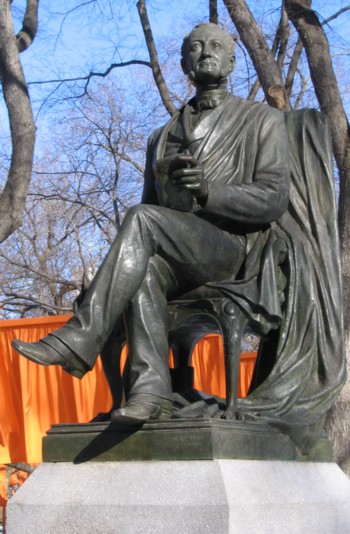I went to see The Gates yesterday. I was going to be in Manhattan on other business, but had a couple free hours in the afternoon, so I thought (
pace my previous comments) I'd go see what all the fuss is about. And, since I'm a hopeless shutterbug, I thought I'd take a few snapshots. Well, depending on your definition of "a few", I did just that. And so, here follows the photo diary of my voyage through the biggest, silliest public art project in many a year.
(Some, but not all, of the photos are just thumbnails to larger photos, panoramic shots and the like that're too big for the main page. The thumbnails have small black borders around them.)

I entered the Park from the southeast corner, through the
Grand Army Plaza, past the statue of William Tecumseh Sherman. I'm not sure if you can tell from the picture, but the pigeons of New York appear to have roughly the same opinion of General Sherman as
Father Tucker.
Speaking of which, here's a shot of my home city's official animal, the feathered rat:

Here he is with his kind. They're fighting over a pretzel.

It's a bird-eat-bird world.
So anyway, the Gates:

The entrance was very crowded. A thick sea of tourists, many clad, at least partially, in orange. Which is funny because, as I learned pretty quickly, the Gates aren't "orange". Apparently, they're "saffron". Looked orange to me, but what do I know?
 Repent, and ye shall be saved.
Repent, and ye shall be saved. This guy was one of the city's many street preachers evangelizing just inside the first Gate. He was quite polite, and we traded a photo for my taking one of his pamphlets (which, to be honest, I haven't read). This is the first example of what will be a recurring theme: the ordinary life of the city goes on, amidst the Gates, as if nothing unusual was happening around them.
Anyway, let me shut up for a little and just show some photos:



Commerce survives the Gates. How come they never have an "Angus"?

Ditto on municipal work.


The last two photos were taken within a couple seconds of each other, from exactly the same location. They highlight one of the things I really liked about the Gates: their mutability. Art is often very fixed, very static. The Gates are fluid - from one second to the next, its never the same piece of art. Sort of like Heraclitus' river, expressed through curtains.


It was around this point that I started to feel silly about taking so many photos. For one, I felt like a common tourist. Also, my camera has limited memory and battery life - one has to ration. What is it that makes people, when confronted with something strange and novel, reach for there camera? Why not just appreciate what you're experiencing? I suppose it's a way of grasping at immortality. Anyway, at about this point I put the camera away for a while.

Ducks on the pond! Life goes on in the animal kingdom as well. I also like this picture for the semi-Impressionist look of the reflection of the Gates in the water. Both the ducks, and the reflection, will reappear.



2.jpg)

Duck fight! My favorite photo of the afternoon. A very New York moment. Two mallards, duking it out over a bread crumb. Not really Gates-related, but kind of cool.

One of the many volunteers who keep the Christo show running. Actually, not volunteers - apparently they get paid. The thing in his hand with the tennis-ball head is the staff they use to disentangle the Gates when they get wrapped around themselves. Christo may be postmodern, but he's intensely practical.
.jpg)
This should give you some sense of the scale of the Gates. (Actually, I'm kind of cheating, because the woman in the picture was pretty short.) The Gates are big, but they seemed, oddly, human-scale. That's another of the things I really liked about the Gates. So much contemporary art seems to want to bludgeon you. The Gates don't do that.


A panoramic view across the duck pond from the bridge shown earlier.

 When you come to a fork in the road, take it.
When you come to a fork in the road, take it. - Yogi Berra

I bet you thought the tennis ball thingee was silly. Who's silly now?

 Dust in the wind... all we are is dust in the wind....
Dust in the wind... all we are is dust in the wind....

The New York skyline, as seen from above Walman Rink.




The patron of
my order.
 Sic transit gloria mundi.
Sic transit gloria mundi. Or, alternately,
My name is Ozymandias, King of Kings:
Look upon my works, ye Mighty, and despair!
Who is this man? He's Fitz-Hugh Halleck, a 19th Century American poet who joins Robert Burns, Sir Walter Scott and William Shakespeare on Literary Walk in Central Park. When they set up Literary Walk 140 years ago, Halleck, who'd just died, doubtless seemed like a giant of poetry. Today, of course, he's almost totally forgotten. There are all sorts of lessons there, about the transitory nature of taste and the difficulty of anticipating what things will endure. In the rest of Literary Walk, of course, they get it right, in part because everyone else had been dead for at least 40 years, and was established as a leading literary light. The Fitz-Hugh Halleck statue, in a lot of ways, sums up why I'm a conservative. How's
that for reading too much into a lump of bronze?

A detail from the steps of the
Bethesda Terrace (situs of the Angel of the Waters fountain). Again, not Gates-related, but beautiful, I think.

This isn't a great photo, but I think it's the best of the lot in terms of conveying what it felt like to be walking under the Gates. It's hard to describe. The best I can say is that it's a tremendous feeling of warmth. Which, given that the actual temperature at this point was about 30 degrees, was nice.

 Life in the wide world goes on, full of its own comings and goings, much has it has this past age.
Life in the wide world goes on, full of its own comings and goings, much has it has this past age.





At about this point, I decided it was time to seek shelter, since my basal body temperature had dropped into the mid-70s. I ducked into the Met for a few minutes until I could feel my hands again, then headed back downtown. (
I have promises to keep, etc, etc) Anyway, one last shot, this one from outside the park looking in:

And then there's this:

I fear I've started something I can no longer control.
Anyway, my overall verdict? Silly. Terminally silly. But basically harmless. Classically postmodern ("weird for the sake of weird"), but as long as you're not looking for some deep meaning about man and nature, or society, or whatever, it's a good time.
UPDATE: Welcome
Crescat Sententia and
Dawn Patrol readers. Please feel free to have a look around. There's lots more inanity, and even a little more photography, where this came from. Be sure not to miss the
bear pornography. Also, for more Gates photos, check out
Photos in the Afternoon

















2.jpg)


.jpg)

































